高一英语必修4 Unit 4 body_language-reading
- 格式:ppt
- 大小:2.05 MB
- 文档页数:29
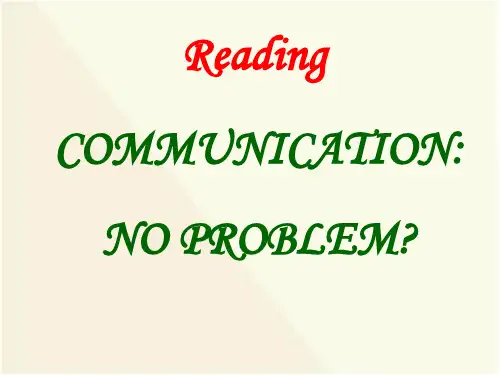

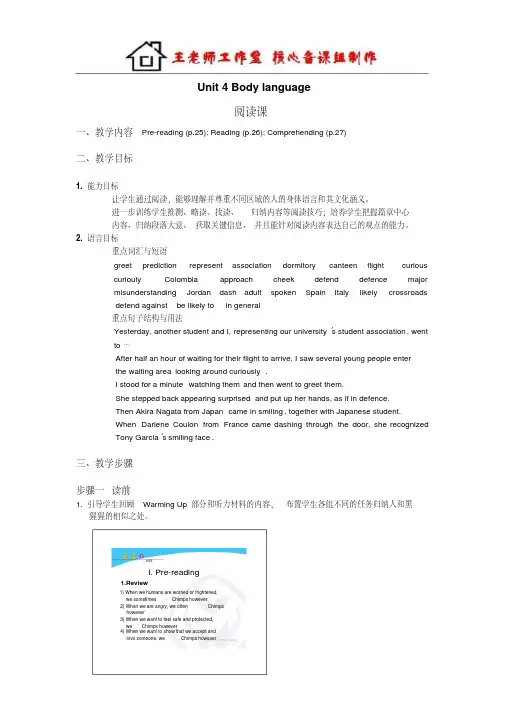
Unit 4 Body language阅读课一、教学内容Pre-reading (p.25); Reading (p.26); Comprehending (p.27)二、教学目标1. 能力目标让学生通过阅读,能够理解并尊重不同区域的人的身体语言和其文化涵义。
进一步训练学生推测、略读、找读、归纳内容等阅读技巧;培养学生把握篇章中心内容、归纳段落大意、获取关键信息、并且能针对阅读内容表达自己的观点的能力。
2. 语言目标重点词汇与短语greet prediction represent association dormitory canteen flight curiouscuriouly Colombia approach cheek defend defence majormisunderstanding Jordan dash adult spoken Spain Italy likely crossroadsdefend against be likely to in general重点句子结构与用法Yesterday, another student and I, representing our university’s student association, wentto …After half an hour of waiting for their flight to arrive, I saw several young people enterthe waiting area looking around curiously.I stood for a minute watching them and then went to greet them.She stepped back appearing surprised and put up her hands, as if in defence.Then Akira Nagata from Japan came in smiling, together with Japanese student.When Darlene Coulon from France came dashing through the door, she recognizedTony Garcia’s smiling face.三、教学步骤步骤一读前1. 引导学生回顾Warming Up部分和听力材料的内容,布置学生各组不同的任务归纳人和黑猩猩的相似之处。
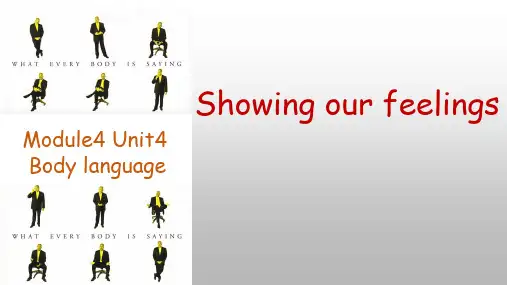
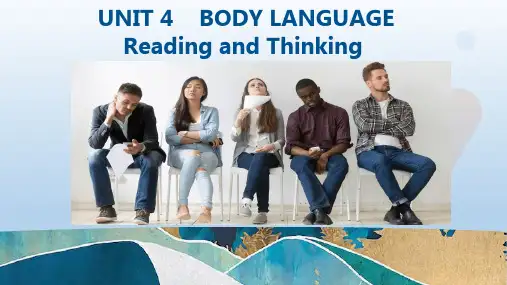
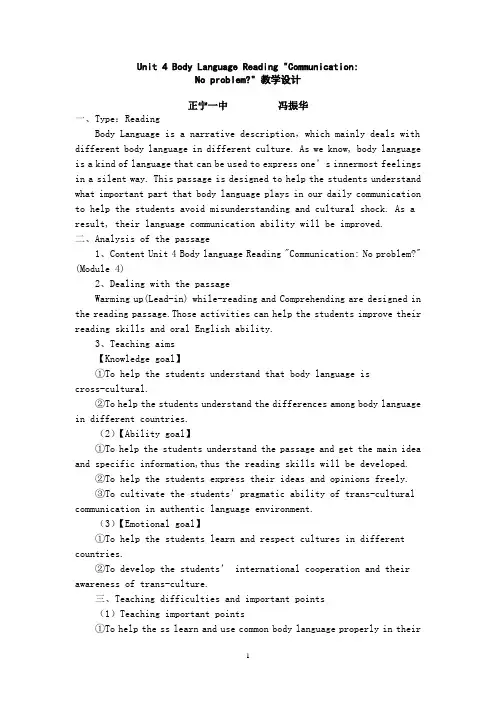
Unit 4 Body Language Reading "Communication:No problem?" 教学设计正宁一中冯振华一、Type:ReadingBody Language is a narrative description,which mainly deals with different body language in different culture. As we know, body language is a kind of language that can be used to express one’s innermost feelings in a silent way. This passage is designed to help the students understand what important part that body language plays in our daily communication to help the students avoid misunderstanding and cultural shock. As a result, their language communication ability will be improved.二、Analysis of the passage1、Content Unit 4 Body language Reading "Communication: No problem?" (Module 4)2、Dealing with the passageWarming up(Lead-in) while-reading and Comprehending are designed in the reading passage.Those activities can help the students improve their reading skills and oral English ability.3、Teaching aims【Knowledge goal】①To help the students understand that body language iscross-cultural.②To help the students understand the differences among body language in different countries.(2)【Ability goal】①To help the students understand the passage and get the main idea and specific information,thus the reading skills will be developed.②To help the students express their ideas and opinions freely.③To cultivate the students’pragmatic ability of trans-cultural communication in authentic language environment.(3)【Emotional goal】①To help the students learn and respect cultures in different countries.②To develop the students’ international cooperation and their awareness of trans-culture.三、Teaching difficulties and important points(1)Teaching important points①To help the ss learn and use common body language properly in theircommunication;②To get the main idea of the text and some key information.(2)Teaching difficulties①To cultivate the students’ reading skills②To help the students learn some cultural misunderstanding caused by body language in different situations.四、Teaching methodTask-based method & Communicative-cooperation method五、Teaching aidsPPT Project Blackboard Chalk六、Teaching design(一)General designThis is a reading comprehension lesson. The key to teaching is to improve the students’ reading skills and strategies. And the teacher will help the ss improve their cultural awareness.To arouse the ss’ interest in the topic, at the very beginning of the class,the teacher uses the students’ familiar gestures (ok, quiet, stop, great) to lead in the topic and asks some students to guess the meaning of each picture. Then the teacher asks some students to perform some body language, thus the atmosphere in the class is lively. At last,the teacher asks the ss: “What is body language?” As a result ,the new lesson is easily lead-in. The design of the reading activities deals with pre-reading, while-reading and post reading, including getting the main idea of the text, specific information and so on , aiming at improving ss’ reading comprehension ability and oral English ability.(二)Teaching proceduresStep 1.Leading in(1)The teacher shows some pictures on the screen. They are about some common gestures used in our daily life. Then asks some ss to guess the meaning of each gesture.(2)The teacher asks some pairs of students to come to the blackboard to perform some body language, while other students to guess what the body language means.Facial expressions: happy, excited, shocked, angry, etcGestures: Victory, well done, quiet, OK, etcPostures: Shake hands, bow, nod ,hug, etcEye contact: Wide-eyed, wink, roll eyes, etcInstructions:通过学生熟悉的手势导入本课,让学生倍感亲切,很自然地过渡到本课的话题。
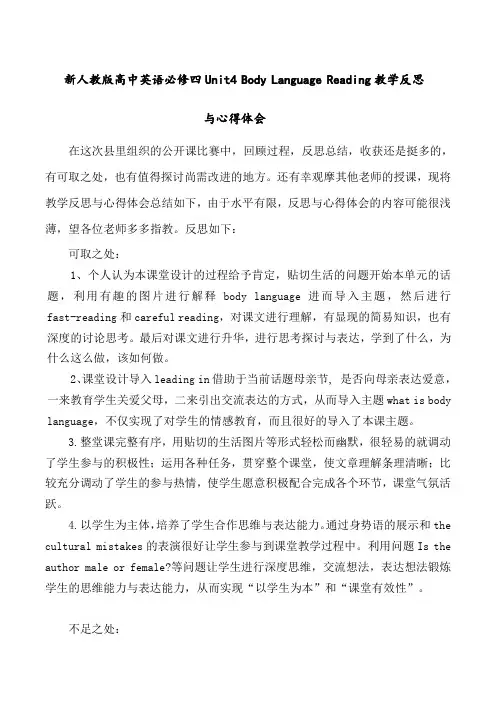
新人教版高中英语必修四Unit4 Body Language Reading教学反思与心得体会在这次县里组织的公开课比赛中,回顾过程,反思总结,收获还是挺多的,有可取之处,也有值得探讨尚需改进的地方。
还有幸观摩其他老师的授课,现将教学反思与心得体会总结如下,由于水平有限,反思与心得体会的内容可能很浅薄,望各位老师多多指教。
反思如下:可取之处:1、个人认为本课堂设计的过程给予肯定,贴切生活的问题开始本单元的话题,利用有趣的图片进行解释body language 进而导入主题,然后进行fast-reading和careful reading,对课文进行理解,有显现的简易知识,也有深度的讨论思考。
最后对课文进行升华,进行思考探讨与表达,学到了什么,为什么这么做,该如何做。
2、课堂设计导入leading in借助于当前话题母亲节, 是否向母亲表达爱意,一来教育学生关爱父母,二来引出交流表达的方式,从而导入主题what is body language,不仅实现了对学生的情感教育,而且很好的导入了本课主题。
3.整堂课完整有序,用贴切的生活图片等形式轻松而幽默,很轻易的就调动了学生参与的积极性;运用各种任务,贯穿整个课堂,使文章理解条理清晰;比较充分调动了学生的参与热情,使学生愿意积极配合完成各个环节,课堂气氛活跃。
4.以学生为主体,培养了学生合作思维与表达能力。
通过身势语的展示和the cultural mistakes的表演很好让学生参与到课堂教学过程中。
利用问题Is the author male or female?等问题让学生进行深度思维,交流想法,表达想法锻炼学生的思维能力与表达能力,从而实现“以学生为本”和“课堂有效性”。
不足之处:1. 学生思考的广度不够,阅读中停留在reading for information较多,而缺少reading for thinking,教学过程中基本上基于信息找寻的问题居多,而进行深入思考的的问题过少而且范围狭窄。
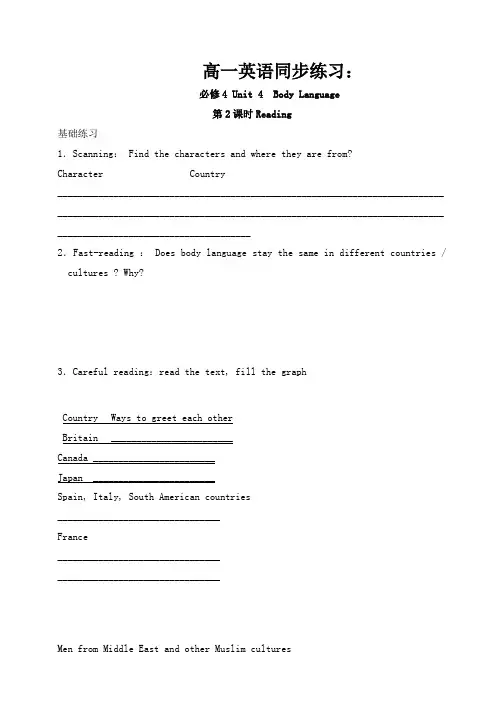
高一英语同步练习:必修4 Unit 4 Body Language第2课时Reading基础练习1.Scanning: Find the characters and where they are from?Character Country____________________________________________________________________________ ____________________________________________________________________________ ______________________________________2.Fast-reading : Does body language stay the same in different countries / cultures ? Why?3.Careful reading:read the text, fill the graphCountry Ways to greet each otherBritain ________________________Canada ________________________Japan ________________________Spain, Italy, South American countries________________________________France________________________________________________________________Men from Middle East and other Muslim cultures实战演练一. 英汉互译1. Yesterday, another student and I, representing our university’s studentassociation, went to the Capital International Airport to meet this year’s international students.______________________________________2.我看见几个年轻人走进了等候区,好奇地四周张望。
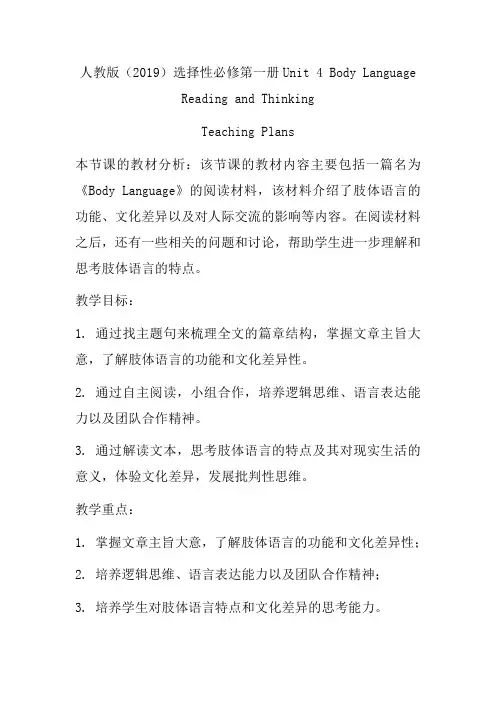
人教版(2019)选择性必修第一册Unit 4 Body LanguageReading and ThinkingTeaching Plans本节课的教材分析:该节课的教材内容主要包括一篇名为《Body Language》的阅读材料,该材料介绍了肢体语言的功能、文化差异以及对人际交流的影响等内容。
在阅读材料之后,还有一些相关的问题和讨论,帮助学生进一步理解和思考肢体语言的特点。
教学目标:1. 通过找主题句来梳理全文的篇章结构,掌握文章主旨大意,了解肢体语言的功能和文化差异性。
2. 通过自主阅读,小组合作,培养逻辑思维、语言表达能力以及团队合作精神。
3. 通过解读文本,思考肢体语言的特点及其对现实生活的意义,体验文化差异,发展批判性思维。
教学重点:1. 掌握文章主旨大意,了解肢体语言的功能和文化差异性;2. 培养逻辑思维、语言表达能力以及团队合作精神;3. 培养学生对肢体语言特点和文化差异的思考能力。
教学难点:1. 帮助学生理解肢体语言对人际交流的重要性,并对肢体语言进行深入思考;2. 培养学生的团队合作精神,让学生在合作中共同完成任务。
学情分析:学生为高一年级的学生,英语水平普遍较低,课本中的阅读材料有一定难度。
学生在日常生活中对肢体语言已有一定的接触和了解,但他们对于肢体语言的功能和文化差异可能还不够清晰。
教学策略:本节课将采用启发式教学策略,通过文本引导学生主动思考和讨论,培养学生的批判性思维能力。
同时,采用小组合作学习形式,通过小组合作完成任务,培养学生的团队合作精神。
教学方法:阅读和讨论、小组合作具体教学过程:1. 导入:根据学生的实际经验,以问题的形式让学生思考肢体语言的重要性和作用。
2. 阅读:让学生自主阅读《Body Language》一文,并在文中找出主题句,理解全文的篇章结构,把握文章主旨大意。
3. 讨论:分成小组进行讨论,分享各自对肢体语言的理解和感受,讨论肢体语言在不同文化背景下的差异。
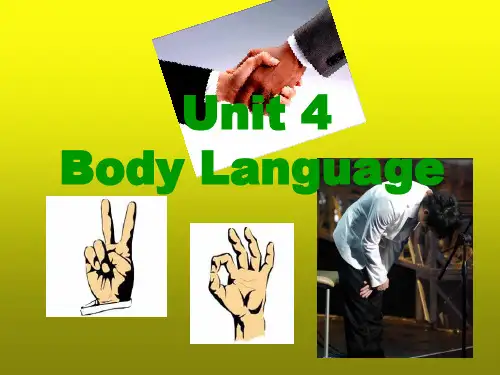
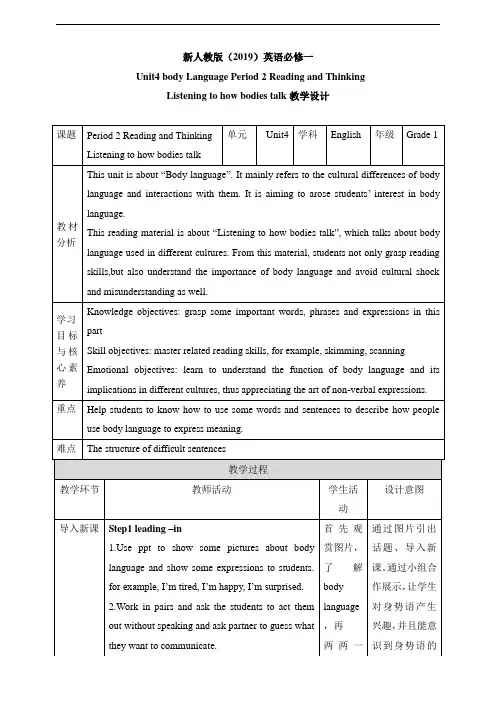
新人教版(2019)英语必修一Unit4 body Language Period 2 Reading and Thinking Listening to how bodies talk教学设计Question:What feelings are they expressing ?And how to express them?组分组讨论,班内展示三四组。
重要性,从而轻松愉悦地参与到课堂活动中去。
讲授新课Step2 While-readingPPT 3, “Pre-reading Questions”What is the main idea of the passage?Answer: Body LanguagePPT4, “Reading of para. 1”1.thought n. 想法2.fold v. 展开;拥抱;交臂fold arms 图片PPT 5, “Question Time”1.Summarize the first paragraph in one sentence.The importance of body languagePPT 6&7, “Reading of para. 2”3.vary vi. 变化;改变4.crucial adj. 关键的5.appropriate adj. 合适的;恰当的6.by contrast 相比之下7.approve vi. 赞成;同意vt. 批准;通过be approved of 被认可8.permit v.允许be permitted to do 被允许做9.demonstrate vt. 表现;表达;说明;证明PPT 8,Summarize the second paragraph in one sentence. 自主阅读,划出关键词。
引导学生快速浏览全文,把握文章的题目和每段的首尾句,理解概括文章大意,从而对学生进行快速阅读训练,提高学生快速阅读的能力。